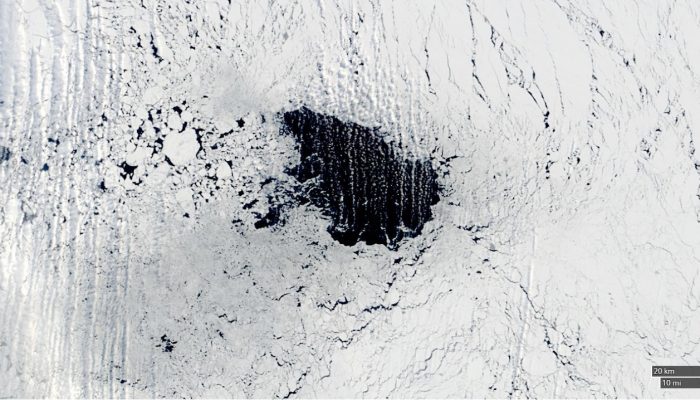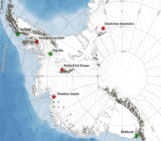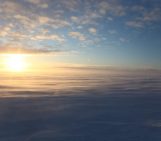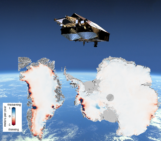
REMARK: If you’ve enjoyed reading this post, please make sure you’ve voted for it in EGU blog competition (2nd choice in the list)!
During both the austral winters of 2016 and 2017, a famous feature of the Antarctic sea-ice cover was observed once again, 40 years after its first observed occurrence: the Weddell Polynya! The sea-ice cover exhibited a huge hole (of around 2600 km2 up to 80,000 km2 at its peak!), as shown on our Image of the Week. What makes this event so unique and special?
Why does the Weddell Polynya form?
The Weddell Polynya is an open ocean polynya (a large hole in the sea ice, see this previous post), observed in the Weddell Sea (see Fig.2). It was first observed in the 1970s but then did not form for a very long time, until 2016 and 2017…

Fig. 2: Map of the sea ice distribution around Antarctica on 25th of September 2017, derived from satellite data. The red circle marks the actual Weddell Polynya [Credit: Modified from meereisportal.de]
In the Southern Ocean, warm saline water masses underlie cold, fresh surface water masses. The upper cold fresh layer acts like a lid, insulating the warmer deep waters from the cold atmosphere. While coastal polynyas (see this previous post) are caused by coastal winds, open ocean polynyas are more mysteriously formed as it is not as clear what causes the warm deep water to be mixed upwards. In the case of the Weddell polynya, it forms above an underwater mountain range, the Maud Rise. This ridge is an obstacle to the water flow and can therefore enhance vertical mixing of the deeper warm saline water masses. The warm water that reaches the surface melts any overlying sea ice, and large amounts of heat is lost from the ocean surface to the atmosphere (see Fig. 3).

Fig. 3: Schematic of polynya formation. The Weddell polynya is an open ocean polynya [Credit: National Snow and Ice Data Center].
Why do we care about the Weddell Polynya?
Overturning and mixing of the water column in the Weddell Polynya forms cold, dense Antarctic Bottom Water, releasing heat stored in the ocean to the atmosphere in the process. Antarctic Bottom Water is formed in the Southern Ocean (predominantly in the Ross and Weddell Seas) and flows northwards, forming the lower branch of the overturning circulation which transports heat from the equator to the poles (see Fig. 4). Antarctic Bottom Water also carries oxygen to the rest of the Earth’s deep oceans. The absence of the Weddell polynya could reduce the formation rate of Antarctic Bottom water, which could weaken the lower branch of the overturning circulation.

Fig.4: Schematic of the overturning (thermohaline) circulation. Deep water formation sites are marked by yellow ovals. Modified from: Rahmstorf, 2002 [©Springer Nature. Used with permission.]
How often does the Weddell Polynya form?
The last time the Weddell Polynya was observed was during the austral winters of 1974 to 1976 (see Fig. 5). It was then absent for nearly 40 years (!) up until austral winter 2016. In a modelling study, de Lavergne et al. 2014 suggested that the Weddell Polynya used to be more common before anthropogenic CO2 emissions started rising at a fast pace. The increased surface freshwater input from melting glaciers and ice sheets, and increased precipitation (as climate change increases the hydrological cycle) have freshened the surface ocean. This freshwater acts again as a lid on top of the warm deeper waters, preventing open ocean convection, reducing the production of Antarctic Bottom Water.

Fig. 5: Color-coded sea ice concentration maps derived from passive microwave satellite data in the Weddell Sea region from the 1970s. The Weddell Polynya is the extensive area of open water (in blue) [Credit: Gordon et al., 2007, ©American Meteorological Society. Used with permission.].
The reappearance of the Weddell Polynya over the past two winters despite the increased surface freshwater input suggests that other natural sources of variability may be currently masking this predicted trend towards less open ocean deep convection. Latif et al. 2013 put forward a theory describing centennial scale variability of Weddell Sea open ocean deep convection, as seen in climate models. In this theory, there are two modes of operation, one where there is no open ocean convection and the Weddell Polynya is not present. In this situation, sea surface temperatures are cold and the deep ocean is warm, and there is relatively large amount of sea ice. The heat at depth increases with time, as it is insulated by the sea ice and freshwater lid. Then, eventually, the deep water becomes warm enough that the stratification is decreased sufficiently so that open water convection begins again, forming the Weddell Polynya. This process continues until the heat reservoir depletes and surface freshwater forcing switches off the deep convection. Models show that the timescale of this variability is set by the stratification, and models with stronger stratification tend to vary on longer timescale, as the heat needs to build up more in order to overcome the stratification.
In the end, the Weddell Polynya is still surrounded by some mystery… Only the next decades will bring us more insight into the true reasons for the appearance and disappearance of the Weddell Polynya…
Further reading
- Latif, M., T. Martin, and W. Park (2013): Southern Ocean sector centennial climate variability and recent decadal trends. J. Climate, 26, 7767–7782.
- de Lavergne, C., Palter, J. B., Galbraith, E. D., Bernardello, R. & Marinov, I. (2014): Cessation of deep convection in the open Southern Ocean under anthropogenic climate change. Nature Clim. Change 4, 278–282.
- Gordon, A. L., Visbeck, M. & Comiso, J. C. (2007): A Possible Link between the Weddell Polynya and the Southern Annular Mode. J. Climate, 20, 2558–2571.
- Image of the Week – What an ice hole!
- Image of the Week – The birth of a sea-ice dragon!
- Image of the Week – Understanding Antarctic Sea Ice Expansion
Edited by Clara Burgard
 Rebecca Frew is a PhD student at the University of Reading (UK). She investigates the importance of feedbacks between the sea ice, atmosphere and ocean for the Antarctic sea ice cover using a hierarchy of climate models. In particular, she is looking at the how the importance of different feedbacks may vary between different regions of the Southern Ocean.
Rebecca Frew is a PhD student at the University of Reading (UK). She investigates the importance of feedbacks between the sea ice, atmosphere and ocean for the Antarctic sea ice cover using a hierarchy of climate models. In particular, she is looking at the how the importance of different feedbacks may vary between different regions of the Southern Ocean.
Contact: r.frew@pgr.reading.ac.uk




